In Asia, AWD technology is a well-known low-cost water-saving technique for irrigated rice. Despite the potential benefits and significant efforts of creating awareness, AWD scaling and adoption remain low in the Philippines. One of the key challenges in the public-managed and large-scale-gravity irrigation system is economic incentives. The decision on AWD adoption was assumed to be influenced by a combination of the socioeconomic factors, institutional arrangements within the irrigators’ association, and biophysical conditions relative to the distance to the water source.
Rice is the staple food for a large part of the world that occupies 162 million (M) hectare (ha) of arable land. Global rice production is 755 M tons (t), of which 89% comes from Asia. Being one of the top three rice-importing countries globally, this crop has high strategic value for the Philippines, both as a staple and the country’s economic growth.
In the Philippines, rice is the most extensively grown crop, with 4.72 M ha and with an annual production of 19 Mt. The largest rice production comes from the Central Plain of Luzon, which contributes 19% to the total national rice production. Like many irrigated rice areas in Asia, the majority of the local farmers practice soil puddling during land preparation and maintain flooded conditions throughout the crop duration except near harvest. This flooding practice results in a higher water footprint for rice than any other crop in the agriculture sector. However, water availability for irrigation in the country has declined due to competing demands from various users (i.e., agriculture, domestic, industry).
Furthermore, the declining availability of water sources brought about by the degradation of watersheds aggravates this water-scarce condition. In addition, the rice farming in the region has been disrupted by El Niño-Southern Oscillation events that worsened water scarcity and negatively-affected rice production, especially in the dry season. Therefore, efficient water management practices are essential to enhance the water productivity of rice, especially in Central Luzon, to contribute to food security in the country.
One widely known water-saving technique introduced in Central Luzon in 2001 is the safe Alternate Wetting and Drying or AWD. Safe AWD involves intermittent irrigation that allows the soil to dry for a few days and re-irrigate based on water level depletion (−15 cm) below soil surface. Safe AWD saves irrigation water by reducing water losses, such as seepage and percolation.
Several field experiments and adaptive trials were conducted to investigate the impact of safe AWD on grain yields and water savings, and productivity. For example, the total water use (irrigation + rainfall) was reduced by 15 to 53% without a significant decrease in grain yield under heavy soils and shallow groundwater tables. While in loamy soil and deep groundwater table, it resulted in some yield loss but high water savings up to 50%. The majority of the reports showed that water productivity increases relative to farmers’ practice. Participatory adaptive trials and capacity building nationwide were also conducted to promote and disseminate the safe AWD for farmers’ adoption.
Moreover, two policy supports were issued to promote safe AWD (i.e., Department of Agriculture-Administrative Order 25–2009 and National Irrigation Administration Memorandum Circular No. 35) in the national irrigation systems. Unfortunately, despite the decade of research and development, the adoption of AWD in the country remains slow and low. Around 84,784 ha of rice fields are irrigated using AWD. That translates to only 3% of the total irrigated rice area of 3.29 M ha in the country. Hence, there is a need to determine the factors that affect the AWD adoption of farmers at the field scale.
Although several impact adoption studies on water-saving technologies, such as AWD, have already been conducted, most of these were done under the communal pump or small-scale irrigation system that has a direct benefit from saving water because of the reduction of fuel and labor costs for pumping water. To our knowledge, there is a limited study conducted under a large-scale gravity irrigation system, particularly in the Philippines, that examines factors influencing the farmers’ decision to adopt AWD technology.
Unlike groundwater as a source of irrigation, the concept of water saving under a large public-managed gravity irrigation system might be less enticing among farmers who were required to pay a minimal fee regardless of the volume of water used. The Free Irrigation Service Act of 2018 aggravates this scenario when irrigation water becomes free in the country. Previous studies suggested that farmers’ lack of direct incentives in this type of irrigation system limits farmers from appreciating water conservation benefits on the macro-scale.
This is especially true in the upstream section of the canal, where water is perceived to be abundant, and water usage is excessive. As a result, downstream farmers unable to get enough water to irrigate their crops. Farmers are more likely to implement water-saving irrigation methods when the irrigation water supply is reliable.
Thus, this study aimed to examine the determinants of farmers’ adoption of AWD technology under a gravity irrigation system. It also examined the AWD impact yield at actual farmers’ fields. We used regression-based approaches and empirical evidence to explain the adoption dynamics of AWD technology in a large-scale gravity irrigation system.
In Asia, AWD technology is a well-known low-cost water-saving technique for irrigated rice. Despite the potential benefits and significant efforts of creating awareness, AWD scaling and adoption remain low in the Philippines. One of the key challenges in the public-managed and large-scale-gravity irrigation system is economic incentives. The decision on AWD adoption was assumed to be influenced by a combination of the socioeconomic factors, institutional arrangements within the irrigators’ association, and biophysical conditions relative to the distance to the water source.
In a typical public-owned gravity irrigation system, irrigation delivery is usually based on rotational irrigation scheduling to cover large hectarages. This setup creates some form of drying period before the next irrigation scheduling during crop growth. Our study showed that AWD adopters are bound within the enforced rotational irrigation scheduling within a turnout of the irrigators’ association.
With the current irrigation management system, the probability of AWD implementation increases when farmers cannot convince IA officials to change the irrigation schedule. In addition, the probability of adoption increased when farmers put a high depth of water in every irrigation until the following schedule. Since farmers have less influence over the release of water through their rotational irrigation setup, “awareness” of AWD did not seem to play a significant role in the adoption. On the impact on yield, we found no significant differences between AWD adopters and non-adopters.
Reflecting on the results of this study, several recommendations need to be advanced in out-scaling the recommended safe AWD in a large-scale-gravity-surface irrigation system:
- The rotational irrigation scheduling must be fine-tuned with the recommended safe AWD to avoid pre-emptive flooding and severe drying of the paddy fields;
- To effectively quantify and monitor the rotational irrigation scheduling based on safe AWD, it is recommended that the country invest in and institutionalize the use of decision-support tools using internet-of-things. This is to estimate the water demand and amount of water to be released and to monitor, verify, and provide irrigation water to a specific region on time;
- In the foresight, to implement the first two recommendations, there is a need to improve and rehabilitate the physical infrastructures of the irrigation system, especially at the canal level.
Many studies have already reported evidence on AWD’s effect at the field level. It is now time to look more closely at opportunities that will spur wide-scale implementation at the irrigation system scale, resulting in substantial irrigation water savings and a lower carbon footprint.
Read the study:
Samoy-Pascual K, Yadav S, Evangelista G, Burac MA, Rafael M, Cabangon R, Tokida T, Mizoguchi M, Regalado MJ. (2022) Determinants in the Adoption of Alternate Wetting and Drying Technique for Rice Production in a Gravity Surface Irrigation System in the Philippines. Water 14(1):5.

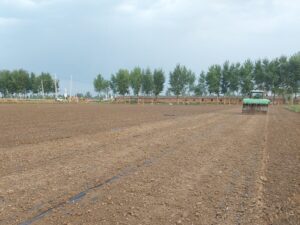
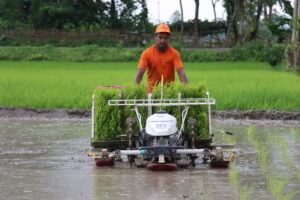
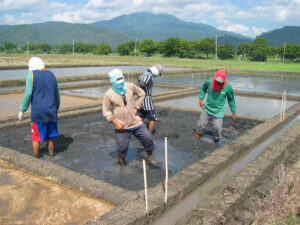
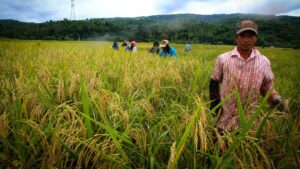
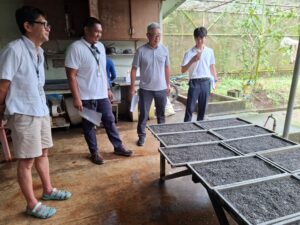
Thanks for this article.
I am a 2-hectare leasehold rice farmer in Cabuyao Ciy, not far from IRRI, and the gravity irrigation system has already been abandoned several decades ago. My area now is actually surrounded by subdivisions where we used to have more than two thousand hectares of rice paddies between Laguna de Bay shoreline and the National Highway.
During rainy days, we have no way to harvest excessive rain water resulting in flooding of rice fields yet dependent on groundwater during dry season.
Moreover, the water-table has been extremely depleted by the nearby factories making beer, soft-drinks and bottled water.
Perhaps the AWD study should also consider situations like ours.